当前位置:
X-MOL 学术
›
Tribol. Int.
›
论文详情
Our official English website, www.x-mol.net, welcomes your
feedback! (Note: you will need to create a separate account there.)
Modelling adhesive wear extension in fretting interfaces: An advection-dispersion-reaction contact oxygenation approach
Tribology International ( IF 6.1 ) Pub Date : 2020-11-01 , DOI: 10.1016/j.triboint.2020.106490 Soha Baydoun , Pierre Arnaud , Siegfried Fouvry
Tribology International ( IF 6.1 ) Pub Date : 2020-11-01 , DOI: 10.1016/j.triboint.2020.106490 Soha Baydoun , Pierre Arnaud , Siegfried Fouvry

|
Abstract This paper aims at modelling contact oxygenation concept which describes the effects of fretting loading conditions on di-oxygen flow within the interface and the associated partition between abrasive and adhesive wear domains in fretting wear scars. This is achieved by modelling oxygen transport within fretting interface using an advection-dispersion-reaction approach (ADR) by considering debris bed as a compact porous medium traversed by atmospheric gases. ADR model is calibrated using three fretting tests of flat-on-flat 34NiCrMo16 interface. Results show that ADR approach can predict the partition of abrasion and adhesion for wide range of sliding frequencies, normal forces and contact sizes. Besides, it can capture the transition of wear mechanisms from pure abrasive to mixed abrasive-adhesive wear at different loading conditions.
中文翻译:

微动界面中的粘附磨损扩展建模:一种对流-弥散-反应接触氧化方法
摘要 本文旨在模拟接触氧化概念,该概念描述了微动载荷条件对界面内双氧流动的影响,以及微动磨损疤痕中磨料和粘着磨损域之间的相关分区。这是通过将碎片床视为大气气体穿过的致密多孔介质,使用对流-弥散-反应方法 (ADR) 模拟微动界面内的氧气传输来实现的。ADR 模型使用三个平面对平面 34NiCrMo16 界面的微动测试进行校准。结果表明,ADR 方法可以预测磨损和粘附的划分,适用于广泛的滑动频率、法向力和接触尺寸。此外,它还可以捕捉不同载荷条件下磨损机制从纯磨料磨损到混合磨料-粘着磨损的转变。
更新日期:2020-11-01
中文翻译:

微动界面中的粘附磨损扩展建模:一种对流-弥散-反应接触氧化方法
摘要 本文旨在模拟接触氧化概念,该概念描述了微动载荷条件对界面内双氧流动的影响,以及微动磨损疤痕中磨料和粘着磨损域之间的相关分区。这是通过将碎片床视为大气气体穿过的致密多孔介质,使用对流-弥散-反应方法 (ADR) 模拟微动界面内的氧气传输来实现的。ADR 模型使用三个平面对平面 34NiCrMo16 界面的微动测试进行校准。结果表明,ADR 方法可以预测磨损和粘附的划分,适用于广泛的滑动频率、法向力和接触尺寸。此外,它还可以捕捉不同载荷条件下磨损机制从纯磨料磨损到混合磨料-粘着磨损的转变。









































 京公网安备 11010802027423号
京公网安备 11010802027423号